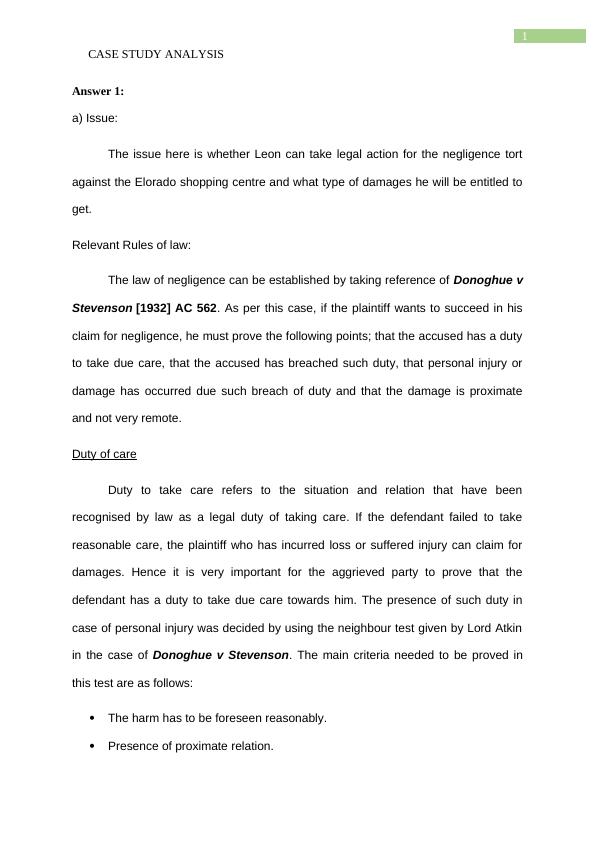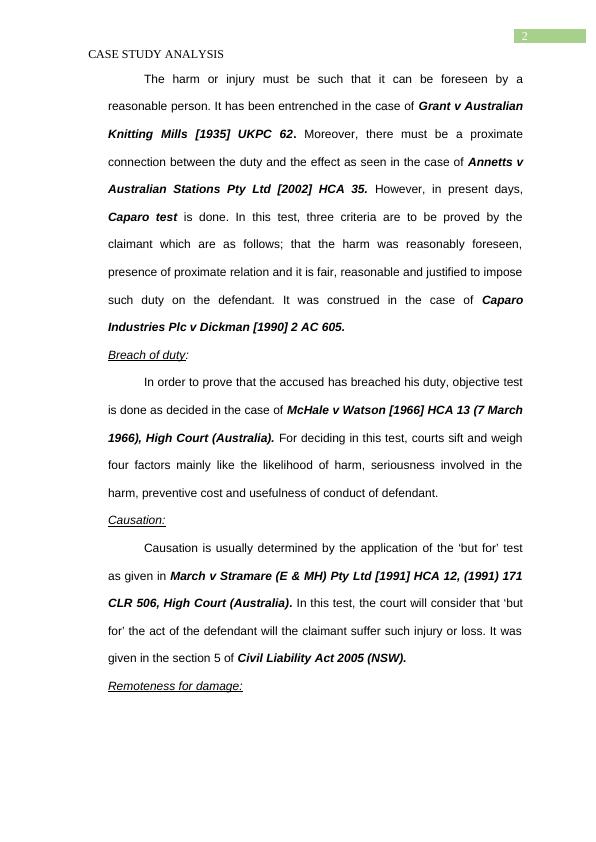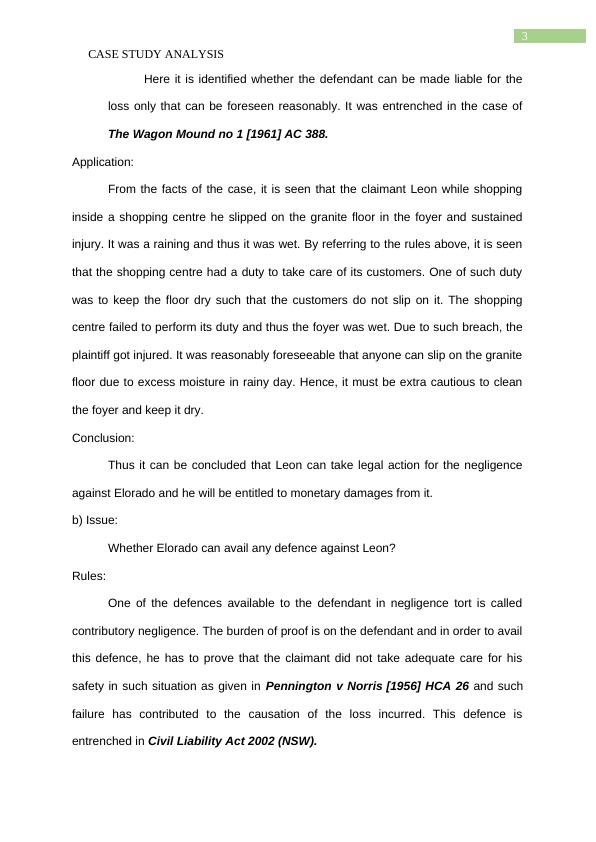Case Study Analysis
Added on 2023-03-31
11 Pages2237 Words188 Views
Running head: CASE STUDY ANALYSIS
CASE STUDY ANALYSIS
Name of the Student
Name of the University
Authors Note
CASE STUDY ANALYSIS
Name of the Student
Name of the University
Authors Note

1
CASE STUDY ANALYSIS
Answer 1:
a) Issue:
The issue here is whether Leon can take legal action for the negligence tort
against the Elorado shopping centre and what type of damages he will be entitled to
get.
Relevant Rules of law:
The law of negligence can be established by taking reference of Donoghue v
Stevenson [1932] AC 562. As per this case, if the plaintiff wants to succeed in his
claim for negligence, he must prove the following points; that the accused has a duty
to take due care, that the accused has breached such duty, that personal injury or
damage has occurred due such breach of duty and that the damage is proximate
and not very remote.
Duty of care
Duty to take care refers to the situation and relation that have been
recognised by law as a legal duty of taking care. If the defendant failed to take
reasonable care, the plaintiff who has incurred loss or suffered injury can claim for
damages. Hence it is very important for the aggrieved party to prove that the
defendant has a duty to take due care towards him. The presence of such duty in
case of personal injury was decided by using the neighbour test given by Lord Atkin
in the case of Donoghue v Stevenson. The main criteria needed to be proved in
this test are as follows:
The harm has to be foreseen reasonably.
Presence of proximate relation.
CASE STUDY ANALYSIS
Answer 1:
a) Issue:
The issue here is whether Leon can take legal action for the negligence tort
against the Elorado shopping centre and what type of damages he will be entitled to
get.
Relevant Rules of law:
The law of negligence can be established by taking reference of Donoghue v
Stevenson [1932] AC 562. As per this case, if the plaintiff wants to succeed in his
claim for negligence, he must prove the following points; that the accused has a duty
to take due care, that the accused has breached such duty, that personal injury or
damage has occurred due such breach of duty and that the damage is proximate
and not very remote.
Duty of care
Duty to take care refers to the situation and relation that have been
recognised by law as a legal duty of taking care. If the defendant failed to take
reasonable care, the plaintiff who has incurred loss or suffered injury can claim for
damages. Hence it is very important for the aggrieved party to prove that the
defendant has a duty to take due care towards him. The presence of such duty in
case of personal injury was decided by using the neighbour test given by Lord Atkin
in the case of Donoghue v Stevenson. The main criteria needed to be proved in
this test are as follows:
The harm has to be foreseen reasonably.
Presence of proximate relation.

2
CASE STUDY ANALYSIS
The harm or injury must be such that it can be foreseen by a
reasonable person. It has been entrenched in the case of Grant v Australian
Knitting Mills [1935] UKPC 62. Moreover, there must be a proximate
connection between the duty and the effect as seen in the case of Annetts v
Australian Stations Pty Ltd [2002] HCA 35. However, in present days,
Caparo test is done. In this test, three criteria are to be proved by the
claimant which are as follows; that the harm was reasonably foreseen,
presence of proximate relation and it is fair, reasonable and justified to impose
such duty on the defendant. It was construed in the case of Caparo
Industries Plc v Dickman [1990] 2 AC 605.
Breach of duty:
In order to prove that the accused has breached his duty, objective test
is done as decided in the case of McHale v Watson [1966] HCA 13 (7 March
1966), High Court (Australia). For deciding in this test, courts sift and weigh
four factors mainly like the likelihood of harm, seriousness involved in the
harm, preventive cost and usefulness of conduct of defendant.
Causation:
Causation is usually determined by the application of the ‘but for’ test
as given in March v Stramare (E & MH) Pty Ltd [1991] HCA 12, (1991) 171
CLR 506, High Court (Australia). In this test, the court will consider that ‘but
for’ the act of the defendant will the claimant suffer such injury or loss. It was
given in the section 5 of Civil Liability Act 2005 (NSW).
Remoteness for damage:
CASE STUDY ANALYSIS
The harm or injury must be such that it can be foreseen by a
reasonable person. It has been entrenched in the case of Grant v Australian
Knitting Mills [1935] UKPC 62. Moreover, there must be a proximate
connection between the duty and the effect as seen in the case of Annetts v
Australian Stations Pty Ltd [2002] HCA 35. However, in present days,
Caparo test is done. In this test, three criteria are to be proved by the
claimant which are as follows; that the harm was reasonably foreseen,
presence of proximate relation and it is fair, reasonable and justified to impose
such duty on the defendant. It was construed in the case of Caparo
Industries Plc v Dickman [1990] 2 AC 605.
Breach of duty:
In order to prove that the accused has breached his duty, objective test
is done as decided in the case of McHale v Watson [1966] HCA 13 (7 March
1966), High Court (Australia). For deciding in this test, courts sift and weigh
four factors mainly like the likelihood of harm, seriousness involved in the
harm, preventive cost and usefulness of conduct of defendant.
Causation:
Causation is usually determined by the application of the ‘but for’ test
as given in March v Stramare (E & MH) Pty Ltd [1991] HCA 12, (1991) 171
CLR 506, High Court (Australia). In this test, the court will consider that ‘but
for’ the act of the defendant will the claimant suffer such injury or loss. It was
given in the section 5 of Civil Liability Act 2005 (NSW).
Remoteness for damage:

3
CASE STUDY ANALYSIS
Here it is identified whether the defendant can be made liable for the
loss only that can be foreseen reasonably. It was entrenched in the case of
The Wagon Mound no 1 [1961] AC 388.
Application:
From the facts of the case, it is seen that the claimant Leon while shopping
inside a shopping centre he slipped on the granite floor in the foyer and sustained
injury. It was a raining and thus it was wet. By referring to the rules above, it is seen
that the shopping centre had a duty to take care of its customers. One of such duty
was to keep the floor dry such that the customers do not slip on it. The shopping
centre failed to perform its duty and thus the foyer was wet. Due to such breach, the
plaintiff got injured. It was reasonably foreseeable that anyone can slip on the granite
floor due to excess moisture in rainy day. Hence, it must be extra cautious to clean
the foyer and keep it dry.
Conclusion:
Thus it can be concluded that Leon can take legal action for the negligence
against Elorado and he will be entitled to monetary damages from it.
b) Issue:
Whether Elorado can avail any defence against Leon?
Rules:
One of the defences available to the defendant in negligence tort is called
contributory negligence. The burden of proof is on the defendant and in order to avail
this defence, he has to prove that the claimant did not take adequate care for his
safety in such situation as given in Pennington v Norris [1956] HCA 26 and such
failure has contributed to the causation of the loss incurred. This defence is
entrenched in Civil Liability Act 2002 (NSW).
CASE STUDY ANALYSIS
Here it is identified whether the defendant can be made liable for the
loss only that can be foreseen reasonably. It was entrenched in the case of
The Wagon Mound no 1 [1961] AC 388.
Application:
From the facts of the case, it is seen that the claimant Leon while shopping
inside a shopping centre he slipped on the granite floor in the foyer and sustained
injury. It was a raining and thus it was wet. By referring to the rules above, it is seen
that the shopping centre had a duty to take care of its customers. One of such duty
was to keep the floor dry such that the customers do not slip on it. The shopping
centre failed to perform its duty and thus the foyer was wet. Due to such breach, the
plaintiff got injured. It was reasonably foreseeable that anyone can slip on the granite
floor due to excess moisture in rainy day. Hence, it must be extra cautious to clean
the foyer and keep it dry.
Conclusion:
Thus it can be concluded that Leon can take legal action for the negligence
against Elorado and he will be entitled to monetary damages from it.
b) Issue:
Whether Elorado can avail any defence against Leon?
Rules:
One of the defences available to the defendant in negligence tort is called
contributory negligence. The burden of proof is on the defendant and in order to avail
this defence, he has to prove that the claimant did not take adequate care for his
safety in such situation as given in Pennington v Norris [1956] HCA 26 and such
failure has contributed to the causation of the loss incurred. This defence is
entrenched in Civil Liability Act 2002 (NSW).

End of preview
Want to access all the pages? Upload your documents or become a member.
Related Documents
Business Laws Solution Assignmentlg...
|8
|1777
|56
Tort Law: Duty of Care and Negligencelg...
|9
|1989
|98
Tort Law: Negligence and Liabilitylg...
|8
|1794
|32
Case Study Assignment on Tort of Negligence and Australian Consumer Lawlg...
|11
|3022
|114
Business Law: Negligence and Recovery of Economic Losslg...
|6
|1050
|191
Contract law Sample Assignmentlg...
|10
|2253
|57
